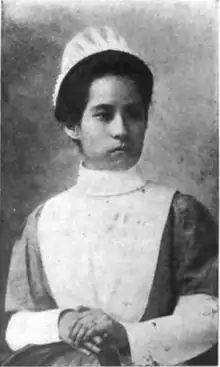Iyo Araki
Iyo Araki (1877-1969), also known as Iyo Araki San and later as Iyo Araki Kubo, was a Japanese nurse and nursing educator. She was superintendent of nurses and head of the nurses' training school at St. Luke's International Hospital in Tokyo from 1903.


Early life
Araki attended St. Margaret's School in Tokyo,[1] and first trained as a nurse in Japan.[2] In 1900 she traveled to the United States to study nursing education, at Old Dominion Hospital in Richmond, Virginia,[3] and Johns Hopkins Hospital in Baltimore, Maryland,[4] sent by an American medical missionary, Dr. Rudolf Teusler.[5]
Career
Araki was on staff at a hospital in Kobe as a young woman.[3] Beginning in 1903, she was superintendent of nurses and head of the nurses' training school at St. Luke's International Hospital in Tokyo,[6] using a curriculum based on the American programs she examined in her studies.[7] She presented a report about tuberculosis in Japan for the Sixth International Congress on Tuberculosis in 1908.[8]
In 1918-1919, Araki led a unit of Japanese nurses working at an American Red Cross hospital at Russian Island.[9] She resigned from teaching duties at St. Luke's in 1920, but remained as superintendent of nurses. She was prominent coordinating the hospital's response in the aftermath of Tokyo's 1923 Great Kantō earthquake, evacuating patients and keeping them alive when the hospital burned.[10] In 1927-1928 she traveled again to the United States, on a fellowship from the Rockefeller Foundation,[11] to study American hospitals. "Miss Araki is something of a national hero in her native country", noted The New York Times in 1927.[12][13]
Personal life
Araki married Rudolf Teusler's assistant and successor as director at St. Luke's, Dr. Tokutarō Kubo, in 1935.[14] She was widowed when Dr. Kubo died in 1941.[15] In 1951 she was honored by the Church of Japan as one of Tokyo's "semicentenarians", marking more than fifty years since her baptism.[16] She died in 1969, aged 92 years.
References
- Margaret Ernestine Burton, The Education of Women in Japan (Fleming H. Revell 1914): 97.
- "At the Hospital" Staunton Spectator and Vindicator (June 29, 1900): 1. via Newspapers.com

- "Around the World" The Spirit of Missions (September 1900): 600.
- "A Surgeon's Mission" The Churchman (October 2, 1909): 490.
- "A Japanese Nurse in America" The Spirit of Missions (November 1900): 748-750.
- R. B. Teusler, "Present-Day Medical Work in Japan" The Spirit of Missions (September 1909): 786.
- Aya Takahashi, The Development of the Japanese Nursing Profession: Adopting and Adapting Western Influences (Psychology Press 2004): 137. ISBN 9780415305792
- Iyo Araki San, "Tuberculosis in Tokyo and Vicinity" Proceedings of Section V: Hygienic, Social, Industrial and Economic Aspects of Tuberculosis (W. F. Fell 1908): 573.
- American National Red Cross, History of American Red Cross Nursing (Macmillan 1922): 913.
- Garrett L. Washington, "St. Luke's Hospital and the Modernisation of Japan, 1847-1928" Health and History 15(2)(2013): 14.
- "Miss Iyo Araki Will Visit U. S. In August" The News Leader (June 15, 1927): 3. via Newspapers.com

- "Japanese Heroine is Here for Study" New York Times (September 14, 1927): 23.
- Iyo Araki, "Nursing in Japan: Its Origin and Development" American Journal of Nursing 28(10)(October 1928): 1003-1006.
- Elisheva Avital Perelman, "The Exponent of Breath: The Role of Foreign Evangelical Organizations in Combating Japan’s Tuberculosis Epidemic of the Early 20th Century" (Ph.D. dissertation, University of California, Berkeley, 2011): 148-149.
- Tokutaro Kubo (1876?-1941), Jane Addams Digital Edition.
- "Semicentenarian Churchpeople" The Living Church (September 2, 1951): 9.